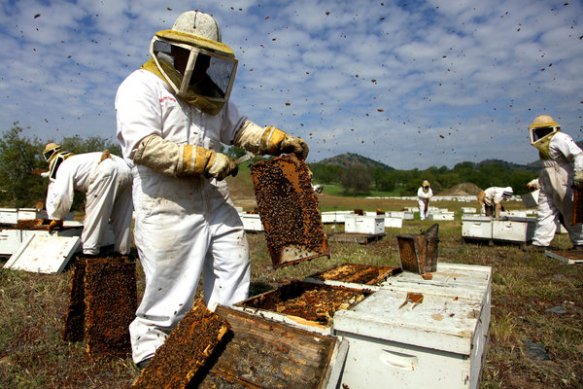Why Big Ag Likes Big Data
By QUENTIN HARDY
Matthew Staver for The New York Times
Looking at data like historic rainfall and soil quality to help farmers predict crop yields can create what one Monsanto executive called “the next level of agriculture.”
Big Data’s push to remake the industrial economy took a big step forward Wednesday, when Monsanto announced it had bought the Climate Corporation.
Monsanto said it was paying $930 million in cash for the company, which looks at data like historic rainfall and soil quality to help farmers predict crop yields. Monsanto hopes to apply the Climate Corporation’s data analysis insight across the company, to create what a Monsanto executive called “the next level of agriculture.”
“A farmer should be able to grow on farmland square meter by square meter, for lots more yield, planting seeds at different rates for each meter,” said Kerry Preete, Monsanto’s executive vice president of strategy. “We’re a data company at heart, breeding seeds and helping farmers optimize yields and manage risk.”
To its critics, Monsanto is something worse, producing genetically modified crops that it then sells to farmers on a one-time use basis. In either version of the company, however, Mr. Preete has a point about the importance of data to Monsanto.
Last year Monsanto paid $250 million for Precision Planting , a company that enables farmers to plant seeds in various depths and spaces, almost by the square meter, so different parts of a farm can get different treatment. Mr. Preete said Monsanto saw this as a first step in developing two-way farm machinery systems that took up and receive data, giving farmers better sense of what to plant and how much water and fertilizer to use.
The company also plans to sell Climate Corporation’s crop insurance products to farmers internationally. Climate Corporation writes these policies in the United States based on a wealth of public data on rainfall, temperature and soil types around the country. It is not clear how well or how quickly this can be deployed internationally.
In effect, Monsanto hopes to do for about one billion acres of worldwide farmland what General Electric hopes to do for the electrical grid and the aviation industry: Gain unprecedented insights into the interaction of products as they work in the world, make them work more efficiently and possibly sell new services based on the insights.
For Climate Corporation, which started life as Weatherbill and hoped to insure miniature golf courses against unexpected showers, the purchase was both a payday and a chance to build an even bigger business inside Monsanto.
“Monsanto already has more research data than anyone else in agriculture,” said David Friedberg, the cofounder and chief executive of Climate Corporation. “Data itself is going to be nearly worthless – you have to sell insights from the data and suggestions of what to do.”
That implies working out entirely new businesses, including new kinds of user interfaces for people on tractors, as opposed to researchers and financial analysts. Clearly, the spending isn’t over for Monsanto.
Or for that matter, for its competitors. As I indicated in another article on Wednesday, Oracle is focusing on the global agriculture sector as a place where it can sell Big Data hardware and software. It wants lots of companies to buy this stuff, and everybody is focusing on farmers in India and China as much as the United States.






